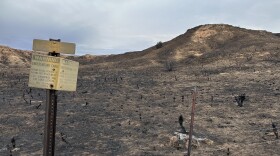Much of Texas is at an elevated risk of wildfires this weekend and early next week because of higher-than-usual temperatures and a worsening drought, according to Texas A&M Forest Service analysts and the state climatologist.
At the same time, vegetation that grew during last summer’s rains is now dormant and brittle — perfect fire starter.
“We are getting into a period of high drying and so we do expect to see fire activity to increase over the weekend and into next week,” said Luke Kanclerz, a wildland fire analyst at Texas A&M Forest Service. He said areas of west central Texas are most at risk of additional fire activity.
Already this month, almost 123,000 acres have burned across the state, according to data provided by Texas A&M Forest Service, more than the previous three Marches combined. The hardest-hit area is Eastland County between Abilene and Fort Worth, where more than 54,000 acres have burned and a sheriff’s deputy died while trying to rescue others from the flames last week.
The fire in Eastland County was unusually intense, experts said, because of a weather phenomenon known as a Southern Plains Wildfire Outbreak, or SPWO, which is characterized by dry vegetation, dry west-southwest winds, low humidity, above-average temperatures and sunny skies. Since 2005, SPWO fires have accounted for only 3% of wildfires reported in Texas but almost half of the total acres burned.
“Last week was a transition to more high-impact fires, meaning they had a higher resistance to control and are much more difficult and dangerous for firefighters to suppress,” Kanclerz said.
The Panhandle, parts of the Hill Country and South Texas have also seen increased wildfire activity in recent weeks. A high risk of fire activity in those areas and west central Texas is projected to remain through the rest of the spring, experts said, because temperatures are expected to keep climbing as the summer approaches and precipitation that could provide relief is likely to remain elusive.
Almost the entire state is considered in a drought, according to the U.S. Drought Monitor. About 40% of the state — mostly north and west Texas — is in an extreme drought, meaning soil moisture is very low, crops fail to germinate and fire danger is high.
September to February was the eighth driest and seventh warmest such six-month period on record, according to data provided by Nielsen-Gammon.
A group of Texas scientists projected in a 2020 paper that the state could see an unprecedented megadrought in the latter half of this century.
“Climate change increases the variability of rainfall,” said Andrew Dessler, a professor of atmospheric science at Texas A&M University. “This increased variability is going to drive worse, more severe droughts. And then, because it rains more when it does rain, that gives you more vegetation to burn.”
Copyright 2022 KERA. To see more, visit KERA. 9(MDA4OTAxNzAzMDEzMjc0MTc2MzA5ZDZlMw004))






